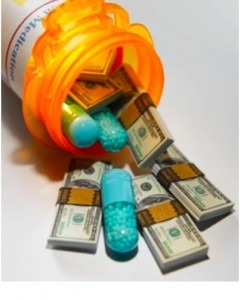By: Dr. John Kyndt ( Head Scientist of the Renewable Energy Program at Advanced Energy Creations Lab) and Dr. Aecio D’Silva.
Anyone interested in life sciences realizes that big pharma companies aren’t producing new drugs fast enough to replace the profits from their major blockbusters. With current economic downturns the innovation in that industry is slowing down even more, but more importantly, key patents for major drugs have (or will soon be) expired.
 Unlike small molecule drugs that have generated profitable generic designs over the last couple of years, the larger molecule drugs are lagging behind in commercialization of what is called biogenerics.
Unlike small molecule drugs that have generated profitable generic designs over the last couple of years, the larger molecule drugs are lagging behind in commercialization of what is called biogenerics.
These biogenerics are also known as biosimilars and follow-on biologics (because they follow patent expiration). They are protein based drugs and typically have a higher complexity in purification and in the way they act.
This makes it harder to produce exact copies of the original drug with the same efficacy, and small, nearly undetectable variations could have significant effects on efficiency and possibly toxicity.
This is an issue not only faced by the biogeneric producers, but also by the original bio-drug manufacturers. Nevertheless many people see these biosimilars as a huge growth area for innovation.
It has been predicted that the biosimilars market will grow to more than $2 billion across Europe by 2014 following key patent expires for biological drugs.
In addition it has been suggested that making a biosimilar costs 1/10 the investment it takes to develop a new biotech drug, and the rate of success in development is 10 times higher.
So what is holding back the full scale production of these biogenerics. In the US, the FDA is seriously behind in opening legal doors for the commercial production of these biosimilars, as compared to the European Medicine Agency (EMEA), which has already released a specific set of guidelines for registration of biosimilar drugs back in 2005.
Since the decision by the EMEA, there has been much lobbying in the US to have a similar process to the European model. Innovator companies are joined by the Generic Pharmaceutical Association (GPhA) in stressing the need for a biogeneric approval pathway to provide patients access to more affordable versions of lifesaving biologic medicines.
Although the FDA has shown initial signs of willingness to develop such pathways, still more work has to be done to define the routes to fast and efficient approval of these biosimilars. However, we believe that now is a good time to start the scientific development which is necessary to get ahead in large-scale commercialization of these biosimilars.
The impeding decision of the FDA is not the only thing holding the commercialization of biosimilars back. There is also the complicated production and increased costs associated with larger molecule drugs as compared to chemical, small moleculre generics. The novel production pathway and quality control for each potential biogeneric target needs to be optimized by a case-by-case scenario.
Nevertheless, there are a number of companies already preparing for these coming opportunities. These companies range in size from small startups to major generic manufacturers, and most of them are located in Europe and India.
However they all realize that the United States is the world’s largest biopharmaceutical market, and therefore, success there is critical to global success.
There is no doubt that lots of opportunities will arise when the regulatory gates are opened and it may be a while before this market becomes saturated.
AlgaeforBiofules is looking ways how inform our members on these opportunities. Algae is a serious candidate or platform to be used to produce these biosimilars.
However, innovator companies should be warned that multibillion dollar biopharmaceutical companies are aware of the disruptive potential of these biogenerics and will not let this jeopardize their profits without putting up a fight.
